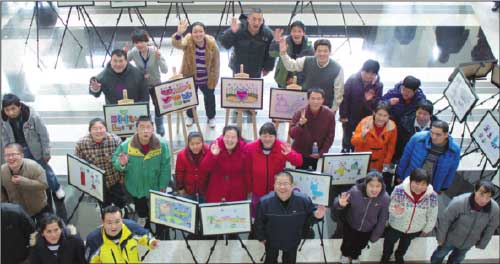當(dāng)前位置: Language Tips> 雙語(yǔ)新聞
【My China Dream】Autism meets art
分享到
 |
|
HeArts students and their family members gather at a painting show in Shanghai. |
|
In 2010, Guo Chenggang suddenly found his 30-month-old son to be "unusual". "He was unable to speak, very sensitive to sound and light. When playing in the kindergarten he would frequently turn to me-all symptoms of autism," Guo recalls. "I was full of guilt. My wife and I focused too much on work and had ignored our child." He decided to return to his family, committing to taking care of his son full time. His son's case proved to be a false alarm. As the boy grew older, the symptoms disappeared. "I guess it was just a period of his growth, but I had gone through all the anxiety, fear and torture that parents of autistic children experience," he says. Afterward, he says, he just could not get back on track and leave those experiences behind after learning so much about autistic children, their parents and families. Today, Guo heads "heArtS", a Shanghai-based charity group that teaches art to mentally impaired people through free painting classes. The 36-year-old man from Wuxi, Jiangsu province, is not an artist himself and says he does not expect to discover the next Vincent Van Gogh. However, he hopes to endow the students with the ability to express themselves-and also give them self-confidence and social recognition. An MBA graduate of Shanghai Jiaotong University with a marketing degree, he had foreseen an ambitious future in business and management. But his encounter with people challenged by autism changed his life. He is now running his NGO full time. He worked for more than two years as a volunteer helping the special-needs group-people with autism, Down syndrome and other mental disorders and illnesses. Last August, Guo and eight friends working in the field established the NGO to provide art classes to special-needs people. By February, the organization was offering free weekly painting lessons to 245 people in 14 communities in Shanghai, Beijing and Hangzhou, with more than 600 paintings being produced each month. Guo believes that people can express their inner selves through art, and says painting is the easiest art form that special-needs people can master. "The art class does not focus on painting skills, and there is not any limitation on the colors or content. Instead, the students are encouraged to bravely express themselves," he says. A crucial part of the art class is sharing. Students are invited to show their work, explain the paintings and answer other students' questions. The courage to express themselves and willingness to communicate with others can overcome the sense of inferiority and isolation that's common in the group, Guo says. Special art shows are regularly held to show the best work of the students. Ye Xiufen, a mother of a mentally ill student, almost shed tears when attending an art show this March in Shanghai. A painting by her 31-year-old daughter was chosen for a public exhibition with other 35 works created by special-needs people in Xujiahui community in the city's Xuhui district. Ye's daughter has studied painting for six months from volunteers of Guo's group, who give lessons from 9 am to 11 am every Thursday morning. "I am really surprised by her progress. She never painted before and had never showed interest in it," Ye says. "The painting class has improved my daughter's ability to think and observe. For example, before, she would wear whatever clothes we chose for her. Now, she has her own ideas on colors. She chooses clothes by herself and matches different shoes." Ye credited her daughter's progress to the efforts of the "loving, caring and responsible volunteer teachers". Wu Jiong, a volunteer teacher of Xujiahui community and a cofounder of Guo's NGO, says that she was touched and inspired by the students. "They are very simple, and their world is small. Once they let you enter their world, you become a very important part of their life. They trust you and depend on you so much," she says. The most frequent question the students ask is "whether you would come to give class next week", Wu says. The feeling is echoed by other volunteers. That makes them determined to eliminate the public's prejudice about the group. "Many people wrongly assume that special-needs groups are unpredictable, dangerous and harmful, fearing that they might attack others. In fact, they are no more offensive than ordinary people," Guo Chenggang says. The NGO is developing a project that aims to help connect people with special needs to their communities. They plan to invite local stores to display and sell the products made from the students' artworks, such as T-shirts, cards, cups and bags. "The residents can realize that the special-needs people exist among us and their work can be a part of our life, and thus eliminate their fears about the group. On the other hand, the painters can receive some financial return," he says. The intellectual-property rights of each painter are strictly ensured, he adds. |
2010年,過(guò)成鋼突然發(fā)現(xiàn)他30個(gè)月大的兒子不太尋常。他回憶說(shuō):“兒子不會(huì)說(shuō)話了,對(duì)聲音和光線卻非常敏感。在幼兒園玩耍時(shí)他常常會(huì)轉(zhuǎn)向我,所有一切都表現(xiàn)出了孤獨(dú)的癥狀。我內(nèi)心充滿愧疚,我和妻子把太多精力放在工作上,忽略了我們的孩子。” 他決定把生活重心轉(zhuǎn)回到家庭,承諾全職照顧他的兒子。 他兒子的這個(gè)案例最后證實(shí)是錯(cuò)誤的警報(bào)。隨著孩子年齡的增長(zhǎng),這些癥狀不見(jiàn)了。 他說(shuō):“我猜這是他成長(zhǎng)的一個(gè)階段,但我卻經(jīng)歷了那些有孤獨(dú)癥孩子的父母所經(jīng)歷的所有焦慮,恐懼和折磨。” 之后,他說(shuō)在了解這么多有關(guān)孤獨(dú)癥兒童,以及他們的父母和家庭后,他不能放下這些經(jīng)歷而再回到以前的生活。 如今,過(guò)成鋼發(fā)起創(chuàng)辦了一家名為“heArtS”(心公藝)的上海慈善公益組織,免費(fèi)教那些精神障礙人士繪畫(huà)。這個(gè)來(lái)自江蘇省無(wú)錫市的36歲男人表示,他自己本身不是藝術(shù)家,也沒(méi)期望去發(fā)現(xiàn)下一個(gè)梵高。 但是,他希望賦予這些學(xué)生進(jìn)行自我表達(dá)的能力,并且培養(yǎng)他們的自信以及幫助他們?nèi)谌肷鐣?huì)。 過(guò)成鋼是上海交通大學(xué)的工商管理碩士,獲市場(chǎng)營(yíng)銷學(xué)位,在商業(yè)和管理方面,他已為自己勾畫(huà)好雄心壯志的將來(lái)。但當(dāng)他遇上那些忍受孤獨(dú)癥的人們時(shí),他們改變了他的生活。他現(xiàn)在全職投身于心公藝——這一民間公益組織的工作中。 他在那作為一名志愿者,已經(jīng)工作兩年多了,幫助那些有孤獨(dú)癥,唐氏綜合癥以及其他精神障礙和疾病的特殊群體。去年八月,他和其他八位在這一領(lǐng)域工作的朋友建立了心公藝,向特殊群體提供藝術(shù)課程。 到今年二月,這個(gè)組織已經(jīng)在上海,北京和杭州的14個(gè)社區(qū)每周免費(fèi)向245名學(xué)員提供繪畫(huà)課程,每個(gè)月都有超過(guò)600幅畫(huà)誕生。 過(guò)成鋼相信人們可以通過(guò)藝術(shù)表達(dá)他們的內(nèi)心,他說(shuō)繪畫(huà)是這個(gè)特殊群體能掌握的最簡(jiǎn)單藝術(shù)形式。 他說(shuō):“藝術(shù)課不強(qiáng)調(diào)繪畫(huà)技法,在色彩和內(nèi)容上不作限制。相反,會(huì)鼓勵(lì)學(xué)生大膽地表達(dá)自己。” 藝術(shù)課很重要的一個(gè)部分是分享。學(xué)生們被邀請(qǐng)展示他們的作品,解釋他們的畫(huà)作并回答其他學(xué)生的提問(wèn)。 過(guò)成鋼說(shuō),自我表達(dá)的勇氣和與他人交流的意愿可以克服這個(gè)群體里共有的自卑和孤獨(dú)。 特殊藝術(shù)展會(huì)定期舉行,展示那些學(xué)生中最好的作品。 葉秀芬是一個(gè)精神障礙患者學(xué)生的母親,今年三月她在上海出席一個(gè)藝術(shù)展時(shí)幾乎淚流滿面。一幅來(lái)自她31歲女兒的畫(huà)作被選中公開(kāi)展出,還有其他同樣出自這個(gè)特殊群體的35幅作品一同在上海徐匯區(qū)的徐家匯社區(qū)展出。 葉秀芬的女兒已經(jīng)在過(guò)成鋼的團(tuán)隊(duì)里學(xué)了6個(gè)月繪畫(huà),每周四上午9點(diǎn)到11點(diǎn)都有自愿者授課。 “我對(duì)她的進(jìn)步既驚又喜。她之前從沒(méi)學(xué)過(guò)繪畫(huà),而且也沒(méi)見(jiàn)她對(duì)繪畫(huà)感興趣。”葉秀芬說(shuō)道。 “繪畫(huà)課提高了我女兒思考和觀察的能力。例如,之前我們給她什么衣服,她就穿什么衣服。現(xiàn)在,她對(duì)衣服的顏色有了自己的想法。她會(huì)自己選擇衣服并且搭配不同的鞋。” 葉秀芬把她女兒的進(jìn)步歸功于這些志愿者老師們的“愛(ài)心,關(guān)注和責(zé)任”。 吳炯是一名徐家匯社區(qū)的志愿者教員,同時(shí)也是過(guò)成鋼的心公藝的共同創(chuàng)辦人之一,她說(shuō)她被這些學(xué)生感動(dòng)并且受到鼓舞。 “他們非常簡(jiǎn)單,他們的世界很小。一旦他們讓你進(jìn)入他們的世界,你就會(huì)變成他們生命中非常重要的一部分。他們會(huì)非常信任你并且依靠你。”她說(shuō)。 吳炯說(shuō)這些學(xué)生最常問(wèn)的問(wèn)題是“你下周還會(huì)來(lái)上課嗎” 其他志愿者也感同身受。這讓這些志愿者下決心要消除公眾對(duì)這個(gè)特殊群體的偏見(jiàn)。 過(guò)成鋼說(shuō):“許多人認(rèn)為特殊群體難以捉摸,危險(xiǎn)且有危害,害怕他們會(huì)攻擊其他人。他們錯(cuò)了,事實(shí)上,他們并不比常人更具攻擊性。” 心公藝正在發(fā)展一個(gè)項(xiàng)目,致力于幫助特殊群體的人融入他們的社區(qū)。 他們計(jì)劃邀請(qǐng)當(dāng)?shù)厣痰陙?lái)展示并出售這些學(xué)生的藝術(shù)品,例如T恤,卡片,杯子和背包。 “這些居民會(huì)認(rèn)識(shí)到,這一特殊群體就生活在我們中間,他們的工作也可以融入我們的生活,這樣就可以消除人們對(duì)這一群體的恐懼。另一方面,這些作畫(huà)者也可以有些收入”,他說(shuō)。 他補(bǔ)充說(shuō),每幅作品的知識(shí)產(chǎn)權(quán)都有嚴(yán)格保障。 (譯者 typhoonda 編輯 Julie) 掃一掃,關(guān)注微博微信
  相關(guān)閱讀 |
上一篇 : 國(guó)民醫(yī)療體系人滿為患 英國(guó)頻現(xiàn)“看牙難”
下一篇 : 為什么要抓著文章不放
分享到
關(guān)注和訂閱


口語(yǔ)
關(guān)于我們 | 聯(lián)系方式 | 招聘信息
電話:8610-84883645
傳真:8610-84883500
Email: languagetips@chinadaily.com.cn